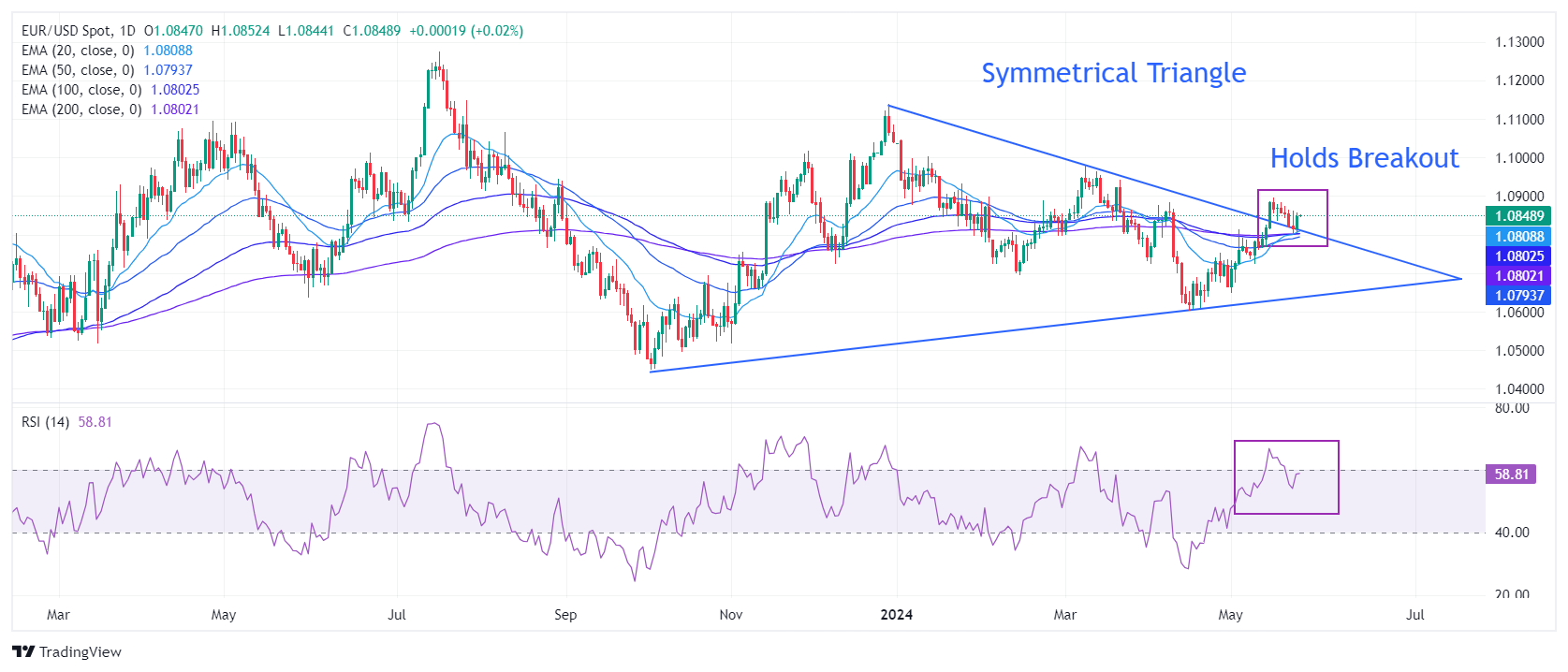- EUR/USD is trading sideways near 1.0850 on a light trading day.
- The euro is rising as investors remain uncertain about whether the ECB will cut interest rates in July.
- Investors expect the Fed to start cutting borrowing rates in the fourth quarter of this year.
EUR/USD traded in a tight range around 1.0850 in the European session on Monday, beginning a calm start to the week ahead of the release of inflation data on both sides of the Atlantic on Friday. The major currency pairs are showing strength as European Central Bank (ECB) policymakers remain reluctant to say whether they will extend the interest rate cutting cycle beyond their June meeting.
ECB policymakers appear reluctant to commit to further rate cuts because they are concerned that aggressive policy easing could lead to a return to price pressures.
In this backdrop, traders have lowered their forecasts for three rate cuts this year and now see only two, due to recent economic indicators that point to continued price pressures, including first-quarter negotiated wage rates and preliminary HCOB Composite Purchasing Managers' Index (PMI) data for May.
Higher wage growth puts more money in household pockets, leading to a big jump in consumer spending and raising inflationary pressures. But ECB governing council member and Bundesbank president Joachim Nagel played down the impact of wage growth, saying it is a lagging indicator and that the longer-term trend is expected to remain weak.
On the economic front, the German IFO Business Environment, Current Situation and Expectations data for May was released. The overall data came in below expectations, but the euro remained unchanged.
Germany's IFO business climate index fell slightly to 89.3 from 89.4 in April after investors had expected a sharp rise to 90.3.
The current economic assessment index fell to 88.3 from 88.9 in April, missing market expectations of 89.9.
The IFO Expectations Index, which indicates companies' outlook for the next six months, was 90.4, below the market consensus of 90.5 but remaining higher than the previous level of 89.7.
Daily Digest Market Trends: EUR/USD remains flat as US markets close
- EUR/USD is trading in a tight range around 1.0850 due to light trading volume due to the Memorial Day US market holiday. Volatility is expected to be high this week as Eurostat is set to release preliminary inflation data for May and the US Bureau of Economic Analysis (BEA) is set to release core Personal Consumption Expenditures Price Index (PCE) data for April. Both reports are due to be released on Friday.
- Investors will be closely following euro zone inflation data as, barring any surprises, ECB policymakers are widely expected to announce a rate cut at their June monetary policy meeting. ECB officials have taken solace in market speculation that they will return to policy normalization in June, but many are reluctant to make any moves beyond that and want to remain data-dependent.
- Expectations for the euro zone's preliminary inflation report suggest that the annual core index, which excludes volatile items such as food, energy, tobacco and alcohol, will stabilize at 2.7%. This headline figure is estimated to have accelerated to 2.5% from 2.4% in April. The inflation data is unlikely to have a major impact on the decision to cut interest rates in June.
- Meanwhile, the US Dollar is stabilizing in the early hours of the European session after a sharp drop on Friday. The US Dollar Index (DXY) fell to 104.65 even as investors lost confidence that the US Federal Reserve will start cutting interest rates at its September meeting.
- Traders see just over a 50% chance that the central bank will keep interest rates on hold in September, according to the CME FedWatch tool, up from 38% last week. The increased likelihood of keeping rates on hold comes after preliminary U.S. PMI data for May came in unexpectedly strong.
- Core PCE inflation data due this week will influence market speculation regarding a Fed rate cut in September. Consumer Price Index (CPI) data for April, released earlier this month, showed that inflationary pressures have cooled after a strong first quarter. This slowdown also suggests that core PCE, the Fed's preferred inflation measure, has softened from its previous reading of 2.7% year-over-year.
Technical reasons: EUR/USD maintains triangle breakout

EUR/USD is hovering around the 1.0850 level ahead of important inflation data for both the Eurozone and the U.S. The major currency pair is strongly holding off a breakout from a symmetrical triangle chart pattern formed on the daily chart, signaling broader strength.
The short-term outlook for the common currency pair remains firm as it is trading above its short- to long-term exponential moving averages (EMAs).
The 14-period Relative Strength Index (RSI) has fallen into the 40.00-60.00 range, suggesting that upside momentum has weakened for now.
In case of further upside, the major pair is expected to retake the two-month high near 1.0900. A decisive breakout above this level would push the asset towards the March 21 high near 1.0950 and psychological resistance at 1.1000. However, a dip below the 200-day EMA at 1.0800 could drag the pair further down.
Frequently asked questions about the Euro
The Euro is the currency of 20 European Union countries that belong to the Eurozone. It is the second most traded currency in the world after the US Dollar. In 2022, it accounted for 31% of all foreign exchange transactions, with an average daily volume of over $2.2 trillion. EUR/USD is the most traded currency pair in the world, accounting for approximately 30% of all transactions, followed by EUR/JPY (4%), EUR/GBP (3%) and EUR/AUD (2%).
The European Central Bank (ECB), located in Frankfurt, Germany, is the reserve bank for the eurozone. The ECB sets interest rates and manages monetary policy. The ECB's main mission is to maintain price stability, which means either keeping inflation down or stimulating growth. The ECB's main tool is to raise or lower interest rates. Relatively higher interest rates, or the expectation of rising interest rates, typically benefit the euro and vice versa. The ECB Governing Council decides monetary policy at its eight meetings per year. Decisions are made by the heads of the eurozone national banks and the six permanent members, including ECB President Christine Lagarde.
Eurozone inflation data, as measured by the Harmonized Index of Consumer Prices (HICP), is an important econometric input for the euro. If inflation rises more than expected, especially if it exceeds the ECB's target of 2%, the ECB will be forced to raise interest rates to keep inflation in check. Relatively high interest rates compared to other countries are usually favorable for the euro, as they make the eurozone a more attractive place for global investors to park their funds.
Data released measures the health of the economy and can affect the euro. Indicators such as GDP, manufacturing and services PMIs, employment, and consumer sentiment surveys can all influence the direction of the single currency. A strong economy is good for the euro. Not only does it attract more foreign investment, it can also trigger the ECB to raise interest rates, which directly strengthens the euro. On the other hand, weak economic data can cause the euro to weaken. Economic data from the eurozone's four largest economies (Germany, France, Italy, and Spain) is particularly important as they account for 75% of the eurozone's economy.
Another important piece of data about the euro is the trade balance. This indicator measures the difference between what a country earns from exports and what it spends on imports over a given period of time. If a country produces exports that are in high demand, its currency will only increase in value due to the additional demand generated by foreign buyers looking to purchase these goods. So, if the trade balance is positive, the currency will strengthen, and vice versa if it is negative.

